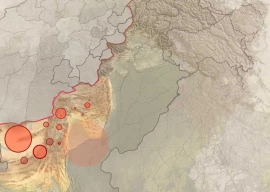
A persistent bull run in the stock market is typically followed by a mood of buoyancy in the asset management industry.
It grows because ordinary people with little know-how about direct stock investing become more interested in mutual funds, which are professionally managed savings and investment schemes designed to cater to a diverse customer base.
However, despite an absolute increase of 149% in the benchmark index of the Karachi Stock Exchange (KSE) between June 2012 and January 2015, total assets under management of the mutual funds industry increased by less than 30% over the same period. They amounted to Rs493.1 billion at the end of the last month.
Speaking to The Express Tribune in a recent interview, Mutual Funds Association of Pakistan (MUFAP) CEO Mashmooma Zehra Majeed said investors shy away from investing in the equity category of mutual funds. She blamed anomalies in taxation for the slow rate of growth of the overall asset management industry.
“Taxation authorities don’t seem to understand the basic concept of mutual funds.
They want to tax them like regular companies. This leads to the creation of tax anomalies that turn investors away,” Majeed said.
Numerous petitions filed by MUFAP against unfair taxation by federal and provincial authorities continue to remain inconclusive, she added.
Workers’ Welfare Fund
Following an amendment to the Workers’ Welfare Fund (WWF) Ordinance in 2008, the Federal Board of Revenue (FBR) ‘assumed’ that savings schemes -- such as mutual funds and voluntary pension plans -- are ‘commercial’ establishments. The FBR started claiming contributions on these schemes and sent notices to mutual funds for WWF payments.
However, MUFAP maintains that mutual funds are not commercial establishments and that WWF applies to asset management companies only. Their point of view is endorsed by the Ministry of Labour and Manpower, which has stated in court that WWP applies to asset management companies, not individual mutual funds that they manage.
The constitutional petition has been pending in the Sindh High Court for over four years.
Sales tax on services
All asset management companies are headquartered in Karachi. They have been paying the provincial sales tax on services to the Sindh Revenue Board (SRB) at 16% since its imposition in 2011. But a conflict of provincial jurisdiction arose in 2012 when the Punjab Revenue Authority (PRA) enacted its own law for the collection of the sales tax on services.
While the SRB law states the sales tax on services is applicable where the service providers are registered, the PRA law calls for its collection where taxable services are rendered. The PRA claims it should receive a proportion of the sales tax on services collected from asset management companies because a fair share of unit-holders resides within Punjab.
According to MUFAP, asset management companies do not owe any tax to the PRA because service providers (companies) as well as recipients (mutual funds) are based in Karachi. The PRA thinks otherwise and continues to demand a share in the sales tax on services, saying the ‘end recipients’ are unit-holders and many of them live in Punjab.
All the attempts to resolve the issue through the Securities and Exchange Commission of Pakistan and the Council of Common Interests have been unsuccessful. The case is pending in the Sindh High Court.
MUFAP is also fighting another case in the Sindh High Court with regard to the imposition of the Federal Excise Duty (FED) on asset management companies by the FBR.
According to Majeed, the imposition of the FED on top of the 16% provincial sales tax on services is tantamount to double taxation. Such lopsided policies are discouraging people to invest through mutual funds, she said.
“The industry’s assets under management should have been at least five times higher than what they are presently,” she said, adding that the current size of the mutual funds industry is no ordinary achievement in the face of constant harassment from tax authorities.
The writer is a staff correspondent
Published in The Express Tribune, February 23rd, 2015.
Like Business on Facebook, follow @TribuneBiz on Twitter to stay informed and join in the conversation.

















COMMENTS
Comments are moderated and generally will be posted if they are on-topic and not abusive.
For more information, please see our Comments FAQ